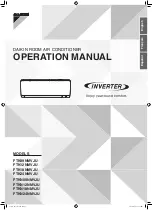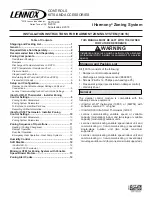
15
Deep Vacuum Method
The deep vacuum method requires a vacuum pump capable of
pulling a vacuum of 500 microns and a vacuum gage capable of
accurately measuring this vacuum depth. The deep vacuum method
is the most positive way of assuring a system is free of air and
liquid water (see Fig. 18).
500
MINUTES
0
1
2
3
4
5
6
7
1000
1500
LEAK IN
SYSTEM
VACUUM TIGHT
TOO WET
TIGHT
DRY SYSTEM
2000
MI
CRONS
2500
3000
3500
4000
4500
5000
A95424
Fig. 18 – Deep Vacuum Graph
Triple Evacuation Method
The triple evacuation method should only be used when vacuum
pump is only capable of pumping down to 28 in. of mercury
vacuum and system does not contain any liquid water.
Refer to Fig. 19 and proceed as follows:
1 Pump system down to 28 in. of mercury and allow pump to
continue operating for an additional 15 minutes.
2 Close service valves and shut off vacuum pump.
3 Connect a nitrogen cylinder and regulator to system and
open until system pressure is 2 psig.
4 Close service valve and allow system to stand for 1 hr.
During this time, dry nitrogen will be able to diffuse
throughout the system absorbing moisture.
5 Repeat this procedure as indicated in Fig. 19. System will
then be free of any contaminants and water vapor.
CHECK FOR TIGHT, DRY SYSTEM
(IF IT HOLDS DEEP VACUUM)
EVACUATE
BREAK VACUUM WITH DRY NITROGEN
WAIT
EVACUATE
RELEASE CHARGE INTO SYSTEM
BREAK VACUUM WITH DRY NITROGEN
EVACUATE
WAIT
A95425
Fig. 19 – Triple Evacuation Method
SEQUENCE OF OPERATION
Interface
A wireless remote control, supplied with the unit, is the interface
between the fan coil and the user. The wireless remote control has
the following characteristics:
S
Capable of displaying
_
C and
_
F with
_
F being the default
setting. To change the default setting, refer to the Owner’s
Manual.
S
The remote control setpoint range is from 62
_
F (17
_
C) to
86
_
F (30
_
C) in increments of 1
_
F (1
_
C).
S
The wireless remote control has an operating range of 25 ft.
(7.62 m).
S
The same remote control can be used to control more than one
unit.
S
If the remote control is lost, damaged, or the batteries are
exhausted, the system can be operated by using the manual
button (forced Auto) located under the front panel.
Manual Button
AUTO/COOL
A14359
Fig. 20 – Manual Button Location on Unit














































